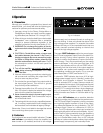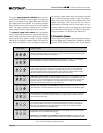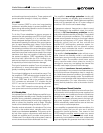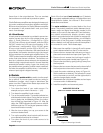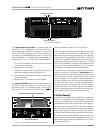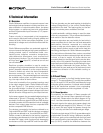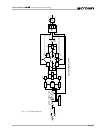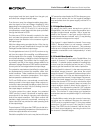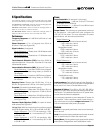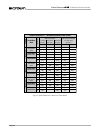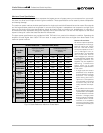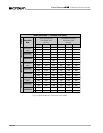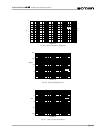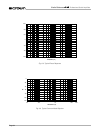
Page 27
Studio Reference
II
II
I
&
IIII
IIII
II
Professional Studio Amplifiers
6 Specifications
The following applies to units in Stereo mode with 8 ohm loads
and an input sensitivity of 26 dB gain unless otherwise specified.
Low-Distortion 1 kHz Power: refers to maximum average power
in watts at 1 kHz with 0.02% THD and noise.
Standard 1 kHz Power: refers to maximum average power in
watts at 1 kHz with 0.1% THD and noise.
Full Bandwidth Power: refers to maximum average power in
watts from 20 Hz to 20 kHz with 0.1% THD and noise.
Performance
Frequency Response: ±0.1 dB 20 Hz to 20 kHz at 1 watt
(see Figure 6.5).
Phase Response: +5 to –15 degrees from 20 Hz to
20 kHz at 1 watt (see Figure 6.8).
Signal-to-Noise: (A-weighted)
Studio Reference
I: Greater than 120 dB below rated
full bandwidth power.
Studio Reference
II: Greater than 117 dB below rated
full bandwidth power.
Total Harmonic Distortion (THD): Less than 0.02% at
rated low-distortion 1 kHz power. Less than 0.1% at rated
full bandwidth power.
Intermodulation Distortion (IMD): (60 Hz and 7 kHz 4:1)
Studio Reference
I: Less than 0.005% from full band-
width power to 78 watts rising linearly to 0.025% at
78 milliwatts.
Studio Reference
II: Less than 0.005% from full band-
width power to 36 watts rising linearly to 0.025% at
36 milliwatts.
Damping Factor: Greater than 20,000 from 10 Hz to
200 Hz, and greater than 2,500 at 1 kHz (see Figure 6.6).
Crosstalk: (At rated full bandwidth power)
Studio Reference
I: Better than 100 dB from 20 Hz to
100 Hz falling linearly to better than 70 dB at 20 kHz
(see Figure 6.10).
Studio Reference
II: Better than 100 dB from 20 Hz to
100 Hz falling linearly to better than 65 dB at 20 kHz
(see Figure 6.10).
Common Mode Rejection (CMR): (At rated full band-
width power) See Figure 6.9.
Voltage Gain: (With level controls set for maximum output)
At the 26 dB gain setting, 20:1 ±3% or 26 dB ±0.25 dB.
Studio Reference
I: At 0.775 volt sensitivity, 103:1
±12% or 40 dB ±1 dB; at 1.4 volt sensitivity 57:1 ±12%
or 35 dB ±1 dB.
Studio Reference
II: At 0.775 volt sensitivity, 69:1
±12% or 37 dB ±1 dB; at 1.4 volt sensitivity 38:1 ±12%
or 32 dB ±1 dB.
Power
Power Bandwidth: (At standard 1 kHz power)
Studio Reference
I: –1 dB from 5 Hz to 27.5 kHz and
–3 dB from 3 Hz to 32.8 kHz.
Studio Reference
II: –1 dB from 5 Hz to 28.6 kHz and
–3 dB from 2.3 Hz to 34.4 kHz.
Output Power:
The following are guaranteed minimums
for low-distortion 1 kHz power from units configured for
120 VAC, 60 Hz power. For more information on power
specifications, see the matrices that follow.
Studio Reference
I
Stereo mode (with both channels driven):
1,160 watts into 4 ohms.
780 watts into 8 ohms.
Bridge-Mono mode:
2,220 watts into 8 ohms.
1,580 watts into 16 ohms.
Parallel-Mono mode:
2,315 watts into 2 ohms.
1,565 watts into 4 ohms.
Studio Reference
II
Stereo mode (with both channels driven):
555 watts into 4 ohms.
355 watts into 8 ohms.
Bridge-Mono mode:
1,110 watts into 8 ohms.
715 watts into 16 ohms.
Parallel-Mono mode:
1,115 watts into 2 ohms.
710 watts into 4 ohms.
Load Impedance: Safe with all types of loads. Rated for 4
to 8 ohms in Stereo mode, 8 to 16 ohms in Bridge-Mono
mode, and 2 to 4 ohms in Parallel-Mono mode.
Required AC Mains: 50 or 60 Hz; 100, 120, 200, 220 or
240 VAC (±10%). Both units draw 90 watts or less at idle.
See Section 7 for detailed information on AC power draw,
current draw and thermal dissipation.
It is extremely important to have adequate AC power for
the amplifier. Power amplifiers cannot create energy—
they must have the required voltage and current to de-
liver the undistorted rated power you expect.
Controls
Enable: A front panel push button used to turn the ampli-
fier on and off.
Level: A front panel rotary potentiometer for each channel
with 31 detents used to control the output level.
Stereo/Mono: A three-position back panel switch used to
select Stereo, Bridge-Mono and Parallel-Mono mode.



